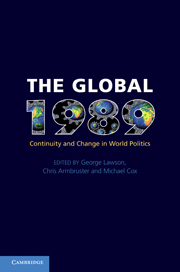Book contents
Conclusion: was there a global 1989?
Published online by Cambridge University Press: 05 June 2012
Summary
Introduction
Symbolic dates in history are a bit like world records in sports; they come out of years of preparation and are in most cases superceded quite quickly. Will 1989, in the view of future historians, be one of those spectacular but quickly superceded anni mirabiles? While few are in doubt that something important changed in 1989 (or thereabouts), the big question is whether the events of that year changed enough things on a global scale to become a dividing line between two eras? The answer, of course, depends on where you see the world from. If priority is given to Europe and to Great Power politics, then 1989 is a true watershed because of the Soviet decision not to prevent democratic change in countries Moscow had controlled since 1945. Outside Europe, and outside great power politics, the picture is less clear. In China, 1989 symbolised the defeat of the student movement for democracy. In Africa and Latin America, 1989 saw the beginning of the end of some odious dictatorships (South Africa and Chile, for example), but also an increase in US interventionism, the growth of murderous and extremist religious movements, and the spread of ethnic strife. In the overall US approach to the world very little changed, it could be argued, even if the Soviet Union ceased to be its main enemy.
- Type
- Chapter
- Information
- The Global 1989Continuity and Change in World Politics, pp. 271 - 281Publisher: Cambridge University PressPrint publication year: 2010
- 1
- Cited by

